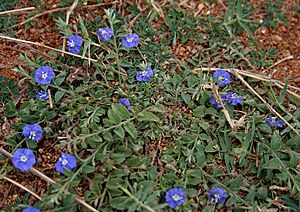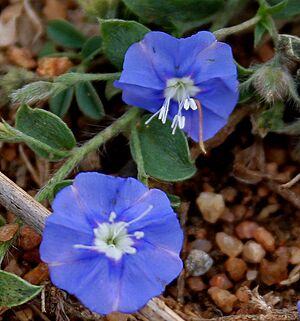Dwarf morning-glory facts for kids
Quick facts for kids Dwarf morning-glory |
|
|---|---|
 |
|
| Scientific classification | |
| Genus: |
Evolvulus
|
| Species: |
alsinoides
|
| Varieties | |
|
|
Evolvulus alsinoides, also known as the dwarf morning-glory, is a beautiful flowering plant. It belongs to the Convolvulaceae family, which includes many types of morning glories. This plant grows naturally in warm parts of the world. You can find it across tropical and warm-temperate areas. These include places like Australia, Southeast Asia, the Pacific Islands, Africa, and the Americas.
Contents
What the Dwarf Morning-Glory Looks Like
The dwarf morning-glory is a herbaceous plant. This means it has soft, green stems, not woody ones like a tree. It can live for just one year (annual) or many years (perennial). Its stems are thin and can either lie flat on the ground or grow upwards. They are covered with fine hairs.
Leaves and Flowers
The leaves of this plant are small. They are about 0.7 to 2.5 centimeters long and 5 to 10 millimeters wide. Some leaves have a short stalk, while others are almost directly attached to the stem.
The flowers are usually blue, but sometimes they can be white. They are small, about 7 to 10 millimeters across. Each flower has a rounded shape with five parts, like a star. The flowers grow either alone or in small groups. They are held up by thin stalks that can be 2.5 to 3.5 centimeters long.
Inside the Flower
The green parts that protect the flower bud are called sepals. These are hairy and pointed. Inside the flower, you'll find the stamens. These are the parts that make pollen. The plant also has an ovary, which is where the seeds will form. It has two thin styles on top.
Seeds and Fruit
After the flower blooms, it produces a small, round fruit. This fruit is like a capsule that opens into four parts. Inside, you will usually find four black, smooth seeds. These seeds help the plant make new plants.
Where the Dwarf Morning-Glory Grows
This plant is very adaptable. It can grow in many different places. You might find it in wet areas like marshes and forests. But it can also survive in dry places like deserts! There are several different types, or varieties, of this plant.
Sometimes, it can grow so well that it becomes a weed in certain areas. In Kerala, a state in India, the dwarf morning-glory is one of the ten sacred flowers known as Dasapushpam. These flowers are important in local traditions.
Plant Chemistry and Uses
People in East Asia have used this herb in traditional medicine for a long time. They believed it could help with brain function and mood. However, scientists have not yet fully proven these claims with medical research.
Scientists have found several natural chemicals in Evolvulus alsinoides. Some of these chemicals include scopoletin, umbelliferone, and scopolin. These compounds are what researchers study to understand the plant's properties.
- Dressler, S.; Schmidt, M.; Zizka, G. (2014). "Evolvulus alsinoides". African plants – a Photo Guide. Frankfurt/Main: Forschungsinstitut Senckenberg. http://www.africanplants.senckenberg.de/root/index.php?submitForm=true&page_id=77&searchTextMenue=Evolvulus+alsinoides&filterRegionIDs%5B%5D=6&filterRegionIDs%5B%5D=1&filterRegionIDs%5B%5D=2&filterRegionIDs%5B%5D=3&filterRegionIDs%5B%5D=5.


